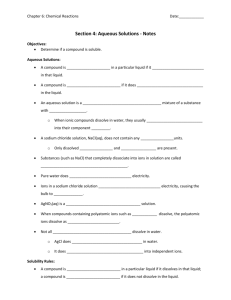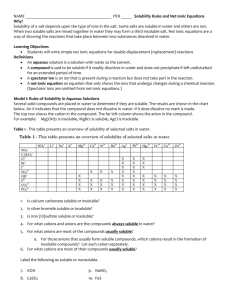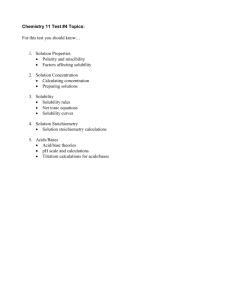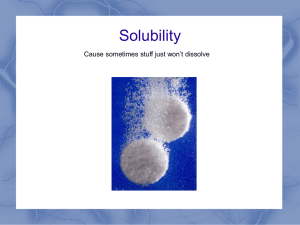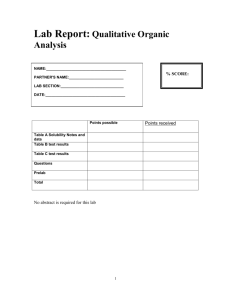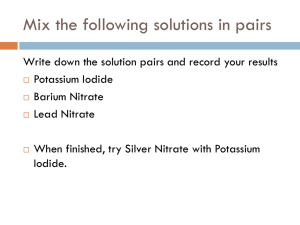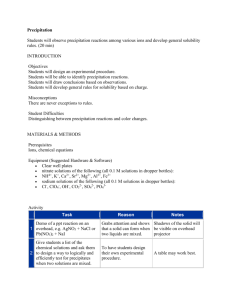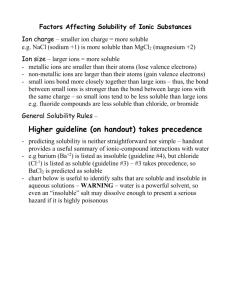SCH 3U Solubility Rules and Dissociation and Net Ionic Equa
advertisement
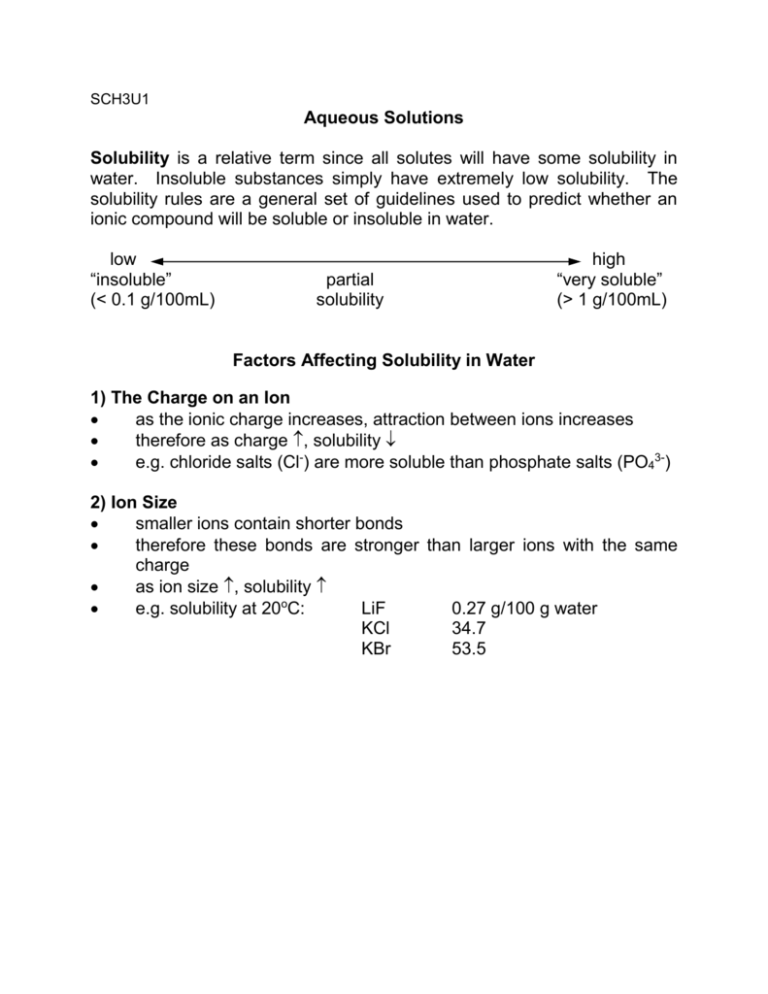
SCH3U1 Aqueous Solutions Solubility is a relative term since all solutes will have some solubility in water. Insoluble substances simply have extremely low solubility. The solubility rules are a general set of guidelines used to predict whether an ionic compound will be soluble or insoluble in water. low “insoluble” (< 0.1 g/100mL) partial solubility high “very soluble” (> 1 g/100mL) Factors Affecting Solubility in Water 1) The Charge on an Ion as the ionic charge increases, attraction between ions increases therefore as charge , solubility e.g. chloride salts (Cl-) are more soluble than phosphate salts (PO43-) 2) Ion Size smaller ions contain shorter bonds therefore these bonds are stronger than larger ions with the same charge as ion size , solubility e.g. solubility at 20oC: LiF 0.27 g/100 g water KCl 34.7 KBr 53.5 SCH3U1 Solubility Rules The following rules are useful for predicting if a salt is soluble or insoluble: Soluble: Compounds containing ammonium (NH4+) or alkali metal ions (Li+, Na+, K+, Rb+, Cs+) are soluble. Compounds containing the nitrate ion (NO3-) are always soluble. Compounds containing Cl-, Br- or I- ions are soluble… except with Ag+, Pb2+, Hg2+ Compounds containing the sulfate ion (SO42-) are soluble… except with Ca2+, Sr2+, Ba2+, Ra2+, Pb2+. Insoluble: Compounds containing carbonate, phosphate or hydroxide ions (CO32-, PO43-, OH-) are insoluble…. except with NH4+, Li+, Na+, K+, Rb+, Cs+ SOLUBILITY RULES Insoluble Soluble CO32-, PO43-, OH- NO3- except with NH4+, Li+, Na+, K+, Rb+, Cs+ NH4+, Li+, Na+, K+, Rb+, Cs+ Cl-, Br-, Iexcept with Ag+, Pb2+, Hg+. SO42except with Ca2+, Sr2+, Ba2+, Ra2+, Pb2+. SOLUBLE or INSOLUBLE? a) Mg(NO3)2 c) (NH4)2CO3 b) NaCl d) Ca3(PO4)2 Dissociation Equations equations that show what positive ion (cations) and negative ions (anions) will appear in a solution. also show the coefficients of the ions produced (they are balanced). e.g. NaCl e.g. Pb(NO3)2 e.g. FeCl3 Precipitation Reactions These are double displacement reactions that occur when 2 solutions are mixed and a solid product is formed. Using the solubility rules, we can predict if a precipitation reaction will occur and the product(s) formed. Predict whether a reaction will occur when each of the following solutions are mixed. If a reaction occurs, complete the following: a) Word Equation b) Balanced Chemical Equation c) Total Ionic Equation (The total ionic equation shows all the ions present in their dissociated form) d) Net Ionic Equation (The net ionic equation shows only those substances which participate in the reaction. The spectator ions are omitted.) e.g.1) sodium carbonate (aq) + barium chloride (aq) e,g, 2) potassium nitrate (aq) + copper (II) chloride (aq) SCH3U1 Solubility Rules, Dissociation Equations and Precipitation Worksheet 1. For each compound, predict if the substance is soluble or insoluble. a) CaCl2 f) Li2SO4 k) Na3PO4 b) KNO3 g) Fe(NO3)3 l) CuCO3 c) CaCO3 h) KBr m) Hg(NO3)2 d) Mg3(PO4)2 i) Ba(OH)2 n) AgCl e) SrSO4 j) BaI2 2. For the following compounds, determine if the compound is soluble. If it is soluble, write the dissociation equation. a) aluminum hydroxide b) potassium hydroxide c) sodium sulfate d) lead (II) chloride e) Iron (III) phosphate f) cesium nitrate g) ammonium phosphate h) magnesium bromide i) tin (IV) nitrate j) barium phosphate 3. For each pair of reactants, predict if a precipitate will form. i) If no precipitate forms, write no reaction (NR). ii) If a precipitate forms, write the balanced chemical reaction, total ionic equation and net ionic equation. Include state symbols in your equations. a) b) c) d) e) f) sodium hydroxide (aq) + potassium carbonate (aq) sodium hydroxide (aq) + iron (III) chloride (aq) magnesium chloride (aq) + silver nitrate (aq) barium chloride (aq) + sodium hydroxide (aq) silver sulfate (aq) + calcium chloride (aq) strontium nitrate (aq) + sodium phosphate (aq) 4. Metal ions can be separated from a mixture by selective precipitation. The technique involves adding a series of aqueous solutions that will selectively precipitate one of the ions. A solution contains the following substances: KNO3 (aq), Pb(NO3)2 (aq), Cu(NO3)2 (aq) and Ba(NO3)2 (aq). Show that the addition of the following solutions in order will leave only one substance in solution. Write the balanced chemical equation and net ionization equation for the reaction that occurs at each step. The solutions added (in order) are i) KCl solution ii) K2SO4 solution and iii) K2CO3 solution.

